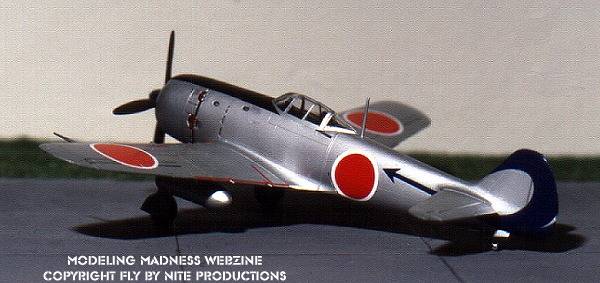
Hasegawa 1/72 Ki-84 "Frank"
Kit Number: B18
Price: $9.00 retail (at the time)
Decals: Two Versions, one bare metal, one camo
Date of Review: 10 February 1998
Review and Photos by: Scott Van Aken

The Kawasaki Ki-84 was undoubtedly one of the finest fighters produced for the Japanese Army during WWII. It was an aircraft, that was able to compete on equal footing with the best the Allies had to offer by the end of the war. Unfortunately, it was saddled with all the problems that befell the Japanese aero industry in the last years of the war; poor quality workmanship and unreliable parts. This combined with inexperienced pilots meant that few 'Hayate's were able to be successfully used.
This Hasegawa kit was built in 1988 straight from the box. As you can see from the photo, this is one of Hasegawa's kits originally released in the late 1970's. It, along with its contemporaries; the P-40E/N, P-47D and J2M3 in this scale are still excellent quality kits. The molding is precise, the transparencies thin and crisp, and the decals, while a bit thick, are a breeze to apply and settle well with no additional solutions required.
This is one kit on which I used almost no putty. What little I did use was on the fuselage and underwing mating surfaces. The interior is relatively complete with seat, stick and instrument panel (a decal is used). The engine is beautifully done and reacts well to a bit of dry brushing when finished. The kit comes with underwing drop tanks and if you install them, you need to punch out the holes in the lower wing to accept them.
Other than the fuselage, the only other part that needs painting is the anti-glare panel. This can be represented with black decal if you wish to avoid painting, but the front part of the cowling does need to be painted as no decal will properly conform to this area. Testor's Aluminum Metallizer was used on the outside of the aircraft while Aotake Blue was (incorrectly it seems) used on the interior and wheel wells. The subject of Japanese interior and wheel well color is one that could easily take a book and this is an area that is not well researched outside Japan. Those of us interested in these things could use a well written tome as the now standard (and highly sought) books by Thorpe are 30 years in age and much new information has been surfaced since 1968. I did use kit decals on this aircraft which consist of the nice, blue 'swoop' of the 29th Sentai.
A highly recommended kit, and the best in this scale. Actually, it is probably the only one currently available in 1/72 as the other one by Tamiya is quite ancient and, due to all the operating features, more of a toy than a scale model.
Back to Reviews Page 2023